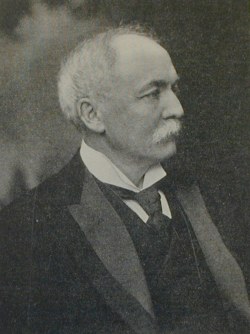 SIR WILLIAM BILSLAND
SIR WILLIAM BILSLAND SIR WILLIAM BILSLAND
SIR WILLIAM BILSLAND SIR WILLIAM BILSLAND was born on St. Patrick's Day, 1847,
at Ballat, near Balfron, of forbears who had been for several centuries farmers
in the neighbouring parish of Kilmaronock. He was educated at Dalmonach School,
Bonhill, living there for the purpose with his uncle, Dr. Alexander Leckie, a
noted physician and temperance advocate. At the age of thirteen he was
apprenticed to a grocer in Glasgow, and remained in his first situation for nine
years, till he started on his own account. This undertaking, begun in Garscube
Road in 1869, was a grocery business. Three years later, feeling the limitations
of his first venture, and with the idea that the baking of bread might be made
one of the great industries of the city, he opened a bakery in Greenhill Street.
To this presently he added by purchase an old-established bakery business in
Elderslie Street, and thus were laid the foundations of the firm of Bilsland
Brothers, and the great Hydepark Bakery which supplies the bread for so large a
number of the citizens of Glasgow. Messrs. Bilsland Brothers further, in 1890,
became partners in the business of Gray, Dunn, & Company, biscuit manufacturers,
and since then that business has made a new departure in prosperity.
After declining several invitations to become a candidate for
the Town Council, Mr. Bilsland entered that body as a member for the Thirteenth
Ward in 1886, and he has continued to represent the same district to the present
day. Among the many committees of the Council upon which he wrought were those
of Health, Hospitals, Museums and Galleries, Libraries, Parks, Statute Labour,
and Street Improvement. On the Health Committee he took part with Sir James
King, Sir John Ure Primrose, and Bailie Crawford in the work of visiting
unhealthy dwellings in all parts of the city, and he had a share in the enquiry
regarding the powers of Local Authorities in other cities in dealing with
unhealthy houses, which resulted in the passing of the Sanitary Act of 1890,
giving the Corporation power to close houses certified as unhealthy. He took an
active part also in the erection of the art Galleries at Kelvingrove, and of the
People's Palace and Winter Garden on the Green. As convener of the Museums and
Galleries' Committee he instituted the successful Saturday Evening Lectures in
the old Corporation Galleries, which have been continued at Kelvingrove, and he
was a strong advocate for the adoption of the Free Libraries" Act. At the
Licensing Courts his decisions have been given on the side of temperance, but
always with a liberal fairness. He is a member of the Merchants' House and the
Chamber of Commerce, and in the Trades' House is a member of the Incorporations
of Bakers, Hammermen, Gardeners, and Coopers. He is an elder in Woodlands U.F.
Church, Vice-President of the Canal Boatmen's Mission, a Director of the
Workmen's Dwellings Company, and the Scottish Temperance Life Assurance Company.
He was a Bailie from 1891 to 1894, and though he did not
often speak at Town Council Meetings, there could be no doubt he was one of the
men of most weight there, and his election as Lord Provost in 1905 was regarded
as an eminently safe and wise choice.
After succeeding to office he more than fulfilled all the
best traditions of the Lord Provostship. He took a constant and energetic part
in furthering the countless varied interests and public enterprises of the city,
and along with Lady Bilsland added fresh warmth and lustre on every occasion to
the civic hospitalities. It was largely to his tact, energy, and initiative that
in 1906 Glasgow owed the success of the celebration of the Quarter-centenary of
George Buchanan. In recognition of the Scottish gift presented to King Haakon
and Queen Maud of Norway on the occasion of their coronation he was received by
their Majesties at Buckingham Palace in November, 1906, and was made a Knight
Commander of the Order of St. Olaf. On the occasion of the visit of the Prince
and Princess of Wales to the city in April, 1907, to open new buildings at the
University, he received, along with their Royal Highnesses, the degree of LL.D.
In June, following the visit of Prince Fushimi of Japan to the city, he received
the Japanese Order of the Sacred Treasure (Third Class), and in November, on the
occasion of King Edward's birthday, he was created a Baronet of the United
Kingdom.
In virtue of his position as Lord Provost he was Lord Lieutenant of the County
of the City of Glasgow and President of the new Territorial Army Association for
that County. He is a Justice of the Peace and Deputy Lieutenant of the Counties
of Glasgow and Lanark, a member of the Carnegie Educational Trust for Scotland,
a member of the Glasgow University Court, a trustee of the National Galleries of
Scotland, and a Fellow of the Society of Antiquaries of Scotland.
Sir William married in 1885 Agnes Anne Steven, third daughter
of the late Alexander Steven of Provanside, and has a family of two sons and two
daughters. The summers he spends at Biggarshiels, near Biggar. On demitting the
Lord Provostship in November, 1908, he went with Lady Bilsland for an extended
stay on the Continent.
Back to
Index of Glasgow Men (1909)